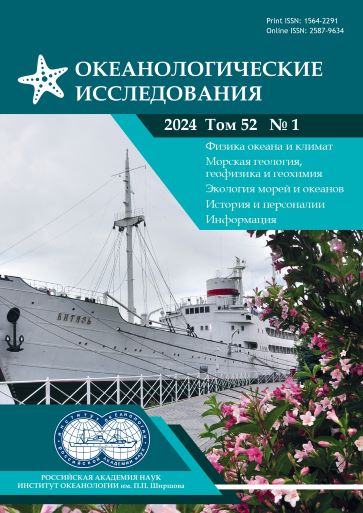THE INFLUENCE OF LOCALIZATION OF POSITIVE SST ANOMALIES IN THE EQUATORIAL PACIFIC OCEAN ON TROPOSPHERESTRATOSPHERIC DYNAMICS IN IDEALIZED MODELING
Abstract
The paper shows the features of the dynamics of the Arctic stratospheric polar vortex (SPV) in winter under various large-scale ocean surface temperature (SST) anomalies in the equatorial zone of the Pacific Ocean. Based on the analysis of idealized modeling data, it was shown that positive SST anomalies in the Niño 3 (canonical El Niño) and Niño 4 (El Niño Modoki) regions lead to SPV weakening of varying degrees. In the experiments, SST anomalies were increased relative to observational data. With equal amplitude of SST anomalies in experiments with boundary conditions corresponding to canonical El Niño (CEN) and El Niño Modoki (ENM), in ENM experiment the vortex is on average 50 % weaker relative to the control experiment for the winter period (November–March), and in CEN experiment, – by 40 %. Analysis of the vertical component of the wave activity showed that in the ENM experiment there is a more intense propagation of Rossby waves from the troposphere to the stratosphere, the main differences are observed in the quasi-stationary planetary wave 2. Moreover, in contrast to some modern studies, it was found that the response of the pressure field in the mid-troposphere to El Niño Modoki is similar to the response to canonical El Niño and is expressed in an intensification of the Pacific-North American Oscillation. The only difference is that in the ENM experiment the negative geopotential anomalies are shifted to the south relative to the Aleutian low, and the maximum positive anomalies are located to the west of the area where they are located in the CEN experiment.
References
- Ashok, K., S. K. Behera, S. A. Rao, H. Weng, and T. Yamagata, 2007: El Niño Modoki and its possible teleconnection. Journal of Geophysical Research: Oceans, 112 (С11).
- Baldwin, M. P. and D. W. J. Thompson, 2009: A critical comparison of stratosphere–troposphere coupling indices. Quarterly Journal of the Royal Meteorological Society: A journal of the atmospheric sciences, applied meteorology and physical oceanography, 135 (644), 1661–1672.
- Barsugli, J. J. and P. D. Sardeshmukh, 2002: Global atmospheric sensitivity to tropical SST anomalies throughout the Indo-Pacific basin. Journal of Climate, 15 (23), 3427–3442.
- Brönnimann, S., J. Luterbacher, J. Staehelin, T. M. Svendby, G. Hansen, and T. Svenøe, 2004: Extreme climate of the global troposphere and stratosphere in 1940–1942 related to El Niño. Nature, 431 (7011).
- Brönnimann, S., 2007: Impact of El Niño-Southern Oscillation on European climate. Reviews of Geophysics, 45 (3).
- Butler, A. H. and L. M. Polvani, 2011: El Niño, La Niña, and stratospheric sudden warmings: A reevaluation in light of the observational record. Geophysical Research Letters, 38 (13).
- Butler, A. H., D. J. Seidel, S. C. Hardiman, N. Butchart, T. Birner, and A. Match, 2015: Defining sudden stratospheric warmings. Bulletin of the American Meteorological Society, 96 (11), 1913–1928.
- Cagnazzo, C., E. Manzini, and N. Calvo, et al., 2009: Northern winter stratospheric temperature and ozone responses to ENSO inferred from an ensemble of Chemistry Climate Models. Atmospheric Chemistry and Physics, 9 (22), 8935–8948.
- Cai, W. and T. Cowan, 2009: La Niña Modoki impacts Australia autumn rainfall variability. Geophysical Research Letters, 36 (12).
- Calvo, N., M. Iza, and M. M. Hurwitz, et al., 2017: Northern hemisphere stratospheric pathway of different El Niño flavors in stratosphere-resolving CMIP5 models. Journal of Climate, 30 (12), 4351–4371.
- Charlton, A. J. and L. M. Polvani, 2007: A new look at stratospheric sudden warmings. Part I: Climatology and modeling benchmarks. Journal of Climate, 20 (3), 449–469.
- Ermakova, T. S., A. V. Koval, S. P. Smyshlyaev, K. A. Didenko, O. G. Aniskina, E. N. Savenkova, and E. V. Vinokurova, 2022: Manifestations of different El Niño types in the dynamics of the extratropical stratosphere. Atmosphere, 13 (12), 2111.
- Feng, J. and J. Li, 2011: Influence of El Niño Modoki on spring rainfall over south China. Journal of Geophysical Research: Atmospheres, 116 (D13).
- Free, M. and D. J. Seidel, 2009: Observed El Niño-Southern Oscillation temperature signal in the stratosphere. Journal of Geophysical Research: Atmospheres, 114 (D23).
- García‐Herrera, R., N. Calvo, R. R. Garcia, and M. A. Giorgetta, 2006: Propagation of ENSO temperature signals into the middle atmosphere: A comparison of two general circulation models and ERA‐40 reanalysis data. Journal of Geophysical Research: Atmospheres, 111 (D6).
- Garfinkel, C. I. and D. L. Hartmann, 2007: Effects of the El Niño–Southern Oscillation and the quasi‐biennial oscillation on polar temperatures in the stratosphere. Journal of Geophysical Research: Atmospheres, 112 (D19).
- Garfinkel, C. I. and D. L. Hartmann, 2008: Different ENSO teleconnections and their effects on the stratospheric polar vortex. Journal of Geophysical Research: Atmospheres, 113 (D18).
- Garfinkel, C. I., A. H. Butler, and D. W. Waugh, et al., 2012: Why might stratospheric sudden warmings occur with similar frequency in El Niño and La Niña winters? Journal of Geophysical Research: Atmospheres, 117 (D19).
- Gushchina, D., M. Kolennikova, B. Dewitte, and S. W. Yeh, 2022: On the relationship between ENSO diversity and the ENSO atmospheric teleconnection to high‐latitudes. International Journal of Climatology, 42 (2), 1303–1325.
- Hurrell, J. W., J. J. Hack, D. Shea, J. M. Caron, and J. Rosinski, 2008: A new sea surface temperature and sea ice boundary dataset for the Community Atmosphere Model. Journal of Climate, 21 (19), 5145–5153.
- Hurwitz, M. M., N. Calvo, and C. I. Garfinkel, et al., 2014: Extra-tropical atmospheric response to ENSO in the CMIP5 models. Climate dynamics, 43, 3367–3376.
- Hurwitz, M. M., I. S. Song, and L. D. Oman et al., 2011: Response of the Antarctic stratosphere to warm pool El Niño events in the GEOS CCM. Atmospheric Chemistry and Physics, 11 (18), 9659–9669.
- Iskandar I., D. O. Lestrai, and M. Nur, 2019: Impact of El Niño and El Niño Modoki Events on Indonesian Rainfall. Makara Journal of Science, 23 (4), 217–222.
- Karpechko, A. Y., P. Hitchcock, D. H. Peters, and A. Schneidereit, 2017: Predictability of downward propagation of major sudden stratospheric warmings. Quarterly Journal of the Royal Meteorological Society, 143 (704), 1459–1470.
- Kolennikova, M. and D. Gushchina, 2022: Revisiting the Contrasting Response of Polar Stratosphere to the Eastern and Central Pacific El Niños. Atmosphere, 13 (5), 682.
- Kug, J. S., F. F. Jin, and S. I. An, 2009: Two types of El Niño events: cold tongue El Niño and warm pool El Niño. Journal of climate, 22 (6), 1499–1515.
- Labitzke K., H. Van Loon, 1989: The Southern Oscillation. Part IX: The influence of volcanic eruptions on the Southern Oscillation in the stratosphere. Journal of climate, 1223–1226.
- Larkin, N. K. and D. E. Harrison, 2005: On the definition of El Niño and associated seasonal average US weather anomalies. Geophysical Research Letters, 32 (13).
- Manzini, E., M. A. Giorgetta, M. Esch, L. Kornblueh, and E. Roeckner, 2006: The influence of sea surface temperatures on the northern winter stratosphere: Ensemble simulations with the MAECHAM5 model. Journal of Climate, 19 (16), 3863–3881.
- Martineau, P. and S. W. Son, 2015: Onset of circulation anomalies during stratospheric vortex weakening events: The role of planetary-scale waves. Journal of Climate, 28 (18), 7347–7370.
- Mo, K. C., 2010: Interdecadal modulation of the impact of ENSO on precipitation and temperature over the United States. Journal of Climate, 23 (13), 3639–3656.
- Plumb, R. A., 1985: On the three-dimensional propagation of stationary waves. Journal of Atmospheric Sciences, 42 (3), 217–229.
- Rayner, N. A. A., D. E. Parker, and E. B. Horton, et al., 2003: Global analyses of sea surface temperature, sea ice, and night marine air temperature since the late nineteenth century. Journal of Geophysical Research: Atmospheres, 108 (D14).
- Reynolds, R. W., T. M. Smith, and C. Liu, 2007: Daily high-resolution-blended analyses for sea surface temperature. Journal of Climate: 20(22), 5473–5496.
- Sassi, F., D. Kinnison, and B. A. Boville, et al., 2004: Effect of El Niño–Southern Oscillation on the dynamical, thermal, and chemical structure of the middle atmosphere. Journal of Geophysical Research: Atmospheres, 109 (D17).
- Sobaeva, D., Y. Zyulyaeva, and S. Gulev, 2023: ENSO and PDO Effect on Stratospheric Dynamics in Isca Numerical Experiments. Atmosphere, 14 (3), 459.
- Taguchi, M. and D. L. Hartmann, 2006: Increased occurrence of stratospheric sudden warmings during El Niño as simulated by WACCM. Journal of Climate, 19 (3), 324–332.
- Taschetto, A. S. and M. H. England, 2009: El Niño Modoki impacts on Australian rainfall. Journal of Climate, 22 (11), 3167–3174.
- Taylor, K. E., D. Williamson, and F. Zwiers, 2000: The sea surface temperature and sea-ice concentration boundary conditions for AMIP II simulations. Program for Climate Model Diagnosis and Intercomparison, Lawrence Livermore National Laboratory, University of California.
- Thomson, S. I. and G. K. Vallis, 2018: Atmospheric response to SST anomalies. Part I: Background-state dependence, teleconnections, and local effects in winter. Journal of the Atmospheric Sciences, 75 (12), 4107–4124.
- Trenberth, K. E. The definition of El Niño, 1997: Bulletin of the American Meteorological Society, 78 (12), 2771–2778.
- Trenberth, K. E., G. W. Branstator, and D. Karoly, 1998: Progress during TOGA in understanding and modeling global teleconnections associated with tropical sea surface temperatures. Journal of Geophysical Research: Oceans, 103 (C7), 14291–14324.
- Vallis, G. K., G. Colyer, and R. Geen, 2018: Isca, V1. 0: A framework for the global modelling of the atmospheres of Earth and other planets at varying levels of complexity. Geoscientific Model Development, 11 (3), 843–859.
- Van Loon, H. and K. Labitzke, 1987: The Southern Oscillation. Part V: The anomalies in the lower stratosphere of the Northern Hemisphere in winter and a comparison with the quasi-biennial oscillation. Monthly Weather Review, 115 (2), 357–369.
- Weinberger, I., C. I. Garfinkel, and I. P. White et al., 2019: The salience of nonlinearities in the boreal winter response to ENSO: Arctic stratosphere and Europe. Climate dynamics, 53, 4591–4610.
- Weng, H., K. Ashok, S. K. Behera, S. A. Rao, and T. Yamagata, 2007: Impacts of recent El Niño Modoki on dry/wet conditions in the Pacific rim during boreal summer. Climate dynamics, 29 (2–3), 113–129.
- Weng, H., S. K. Behera, and T. Yamagata, 2009: Anomalous winter climate conditions in the Pacific rim during recent El Niño Modoki and El Niño events. Climate Dynamics, 32 (5), 663–674.
- White, I., C. I. Garfinkel, and E. P. Gerber, 2019: The downward influence of sudden stratospheric warmings: Association with tropospheric precursors. Journal of Climate, 32 (1), 85–108.
- Xie, F., J. Li, W. Tian, J. Feng, and Y. Huo, 2012: Signals of El Niño Modoki in the tropical tropopause layer and stratosphere.Atmospheric Chemistry and Physics, 12 (11), 5259–5273.
- Yeh, S. W., J. S. Kug, and B. Dewitte, et al., 2009: El Niño in a changing climate. Nature, 461 (7263), 511–514.
- Zhang, W., J. Li, and X. Zhao, 2010: Sea surface temperature cooling mode in the Pacific cold tongue. Journal of Geophysical Research: Oceans, 115 (C12).
- Zheleznova, I. V., 2015: Response in the ocean-atmosphere system to canonical El Niño and El Niño Modoki. Dissertation for the degree of PhD of Geographical Sciences, Moscow, 264 p.
- Zhu, Z. and T. Li, 2016: A new paradigm for continental US summer rainfall variability: Asia–North America teleconnection. Journal of Climate, 29 (20), 7313–7327.
- Zhu, Z. and T. Li, 2018: Amplified contiguous United States summer rainfall variability induced by East Asian monsoon interdecadal change. Climate Dynamics, 50 (9–10), 3523–3536.
- Zubiaurre, I. and N. Calvo, 2012: The El Niño–Southern Oscillation (ENSO) Modoki signal in the stratosphere. Journal of Geophysical Research: Atmospheres, 117 (D4).
Transfer of copyrights occurs on the basis of a license agreement between the Author and Shirshov Institute of Oceanology, RAS










